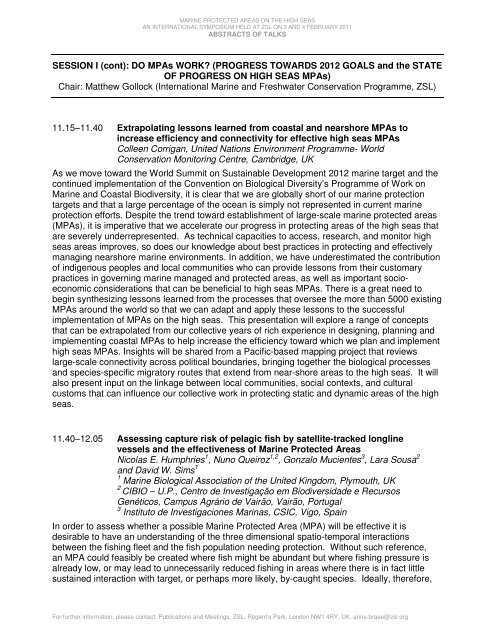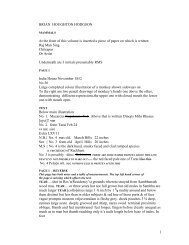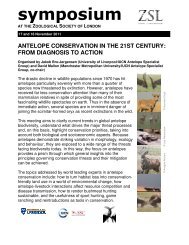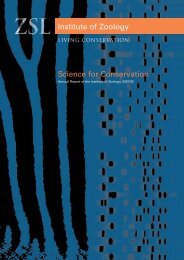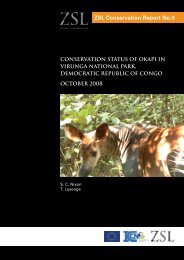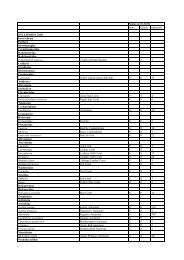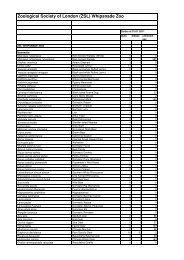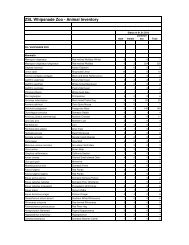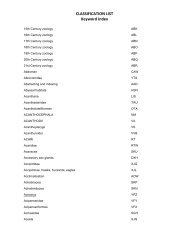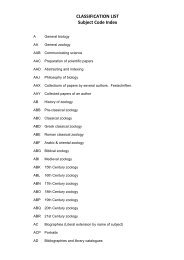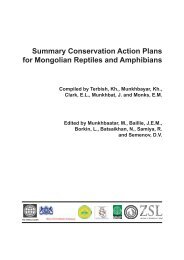MPA Symposium - Zoological Society of London
MPA Symposium - Zoological Society of London
MPA Symposium - Zoological Society of London
Create successful ePaper yourself
Turn your PDF publications into a flip-book with our unique Google optimized e-Paper software.
MARINE PROTECTED AREAS ON THE HIGH SEAS<br />
AN INTERNATIONAL SYMPOSIUM HELD AT ZSL ON 3 AND 4 FEBRUARY 2011<br />
ABSTRACTS OF TALKS<br />
SESSION I (cont): DO <strong>MPA</strong>s WORK? (PROGRESS TOWARDS 2012 GOALS and the STATE<br />
OF PROGRESS ON HIGH SEAS <strong>MPA</strong>s)<br />
Chair: Matthew Gollock (International Marine and Freshwater Conservation Programme, ZSL)<br />
11.15–11.40 Extrapolating lessons learned from coastal and nearshore <strong>MPA</strong>s to<br />
increase efficiency and connectivity for effective high seas <strong>MPA</strong>s<br />
Colleen Corrigan, United Nations Environment Programme- World<br />
Conservation Monitoring Centre, Cambridge, UK<br />
As we move toward the World Summit on Sustainable Development 2012 marine target and the<br />
continued implementation <strong>of</strong> the Convention on Biological Diversity’s Programme <strong>of</strong> Work on<br />
Marine and Coastal Biodiversity, it is clear that we are globally short <strong>of</strong> our marine protection<br />
targets and that a large percentage <strong>of</strong> the ocean is simply not represented in current marine<br />
protection efforts. Despite the trend toward establishment <strong>of</strong> large-scale marine protected areas<br />
(<strong>MPA</strong>s), it is imperative that we accelerate our progress in protecting areas <strong>of</strong> the high seas that<br />
are severely underrepresented. As technical capacities to access, research, and monitor high<br />
seas areas improves, so does our knowledge about best practices in protecting and effectively<br />
managing nearshore marine environments. In addition, we have underestimated the contribution<br />
<strong>of</strong> indigenous peoples and local communities who can provide lessons from their customary<br />
practices in governing marine managed and protected areas, as well as important socioeconomic<br />
considerations that can be beneficial to high seas <strong>MPA</strong>s. There is a great need to<br />
begin synthesizing lessons learned from the processes that oversee the more than 5000 existing<br />
<strong>MPA</strong>s around the world so that we can adapt and apply these lessons to the successful<br />
implementation <strong>of</strong> <strong>MPA</strong>s on the high seas. This presentation will explore a range <strong>of</strong> concepts<br />
that can be extrapolated from our collective years <strong>of</strong> rich experience in designing, planning and<br />
implementing coastal <strong>MPA</strong>s to help increase the efficiency toward which we plan and implement<br />
high seas <strong>MPA</strong>s. Insights will be shared from a Pacific-based mapping project that reviews<br />
large-scale connectivity across political boundaries, bringing together the biological processes<br />
and species-specific migratory routes that extend from near-shore areas to the high seas. It will<br />
also present input on the linkage between local communities, social contexts, and cultural<br />
customs that can influence our collective work in protecting static and dynamic areas <strong>of</strong> the high<br />
seas.<br />
11.40–12.05 Assessing capture risk <strong>of</strong> pelagic fish by satellite-tracked longline<br />
vessels and the effectiveness <strong>of</strong> Marine Protected Areas<br />
Nicolas E. Humphries 1 , Nuno Queiroz 1,2 , Gonzalo Mucientes 3 , Lara Sousa 2<br />
and David W. Sims 1<br />
1 Marine Biological Association <strong>of</strong> the United Kingdom, Plymouth, UK<br />
2 CIBIO – U.P., Centro de Investigação em Biodiversidade e Recursos<br />
Genéticos, Campus Agrário de Vairão, Vairão, Portugal<br />
3 Instituto de Investigaciones Marinas, CSIC, Vigo, Spain<br />
In order to assess whether a possible Marine Protected Area (<strong>MPA</strong>) will be effective it is<br />
desirable to have an understanding <strong>of</strong> the three dimensional spatio-temporal interactions<br />
between the fishing fleet and the fish population needing protection. Without such reference,<br />
an <strong>MPA</strong> could feasibly be created where fish might be abundant but where fishing pressure is<br />
already low, or may lead to unnecessarily reduced fishing in areas where there is in fact little<br />
sustained interaction with target, or perhaps more likely, by-caught species. Ideally, therefore,<br />
For further information, please contact: Publications and Meetings, ZSL, Regent’s Park, <strong>London</strong> NW1 4RY, UK. anne.braae@zsl.org


